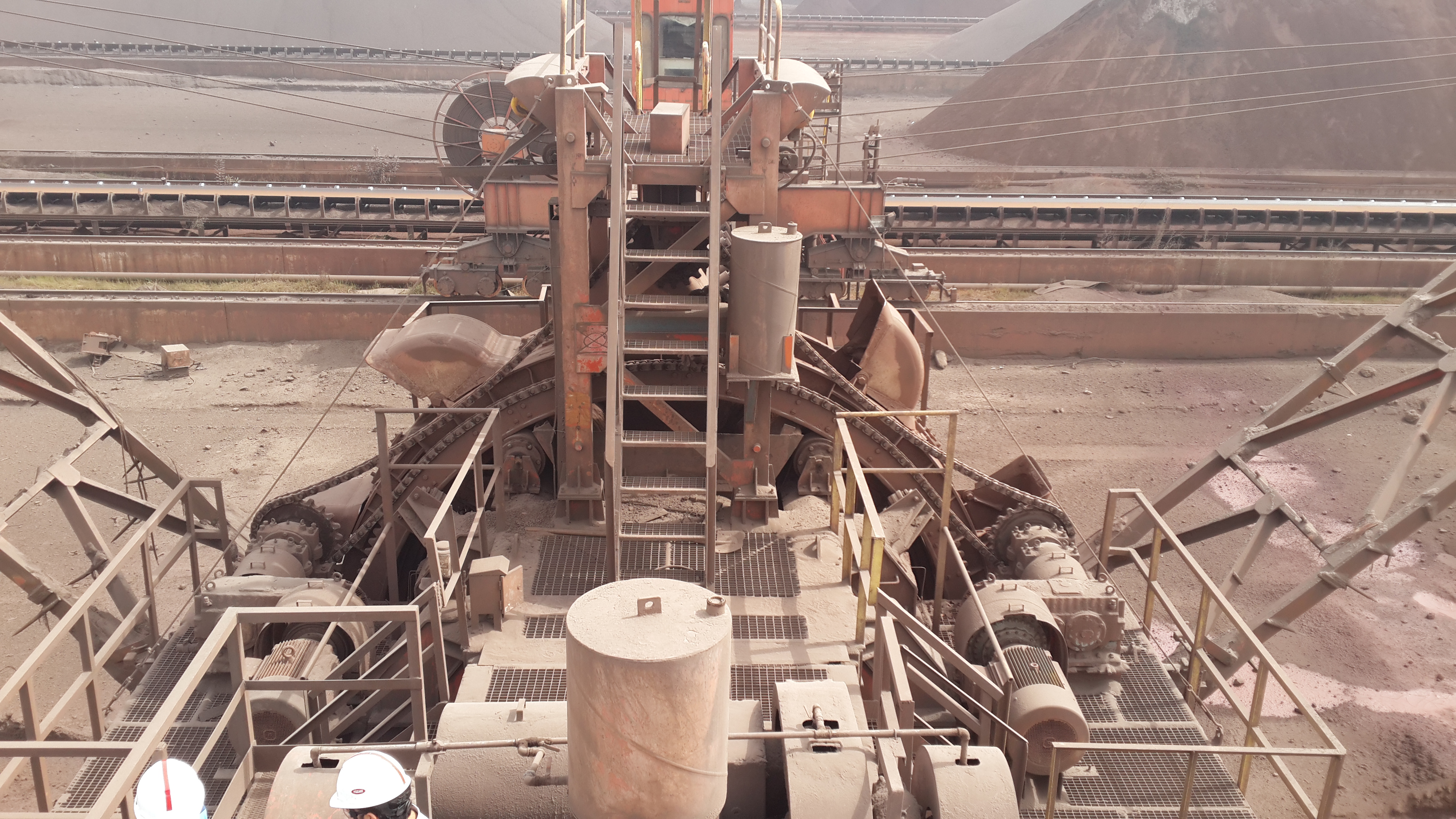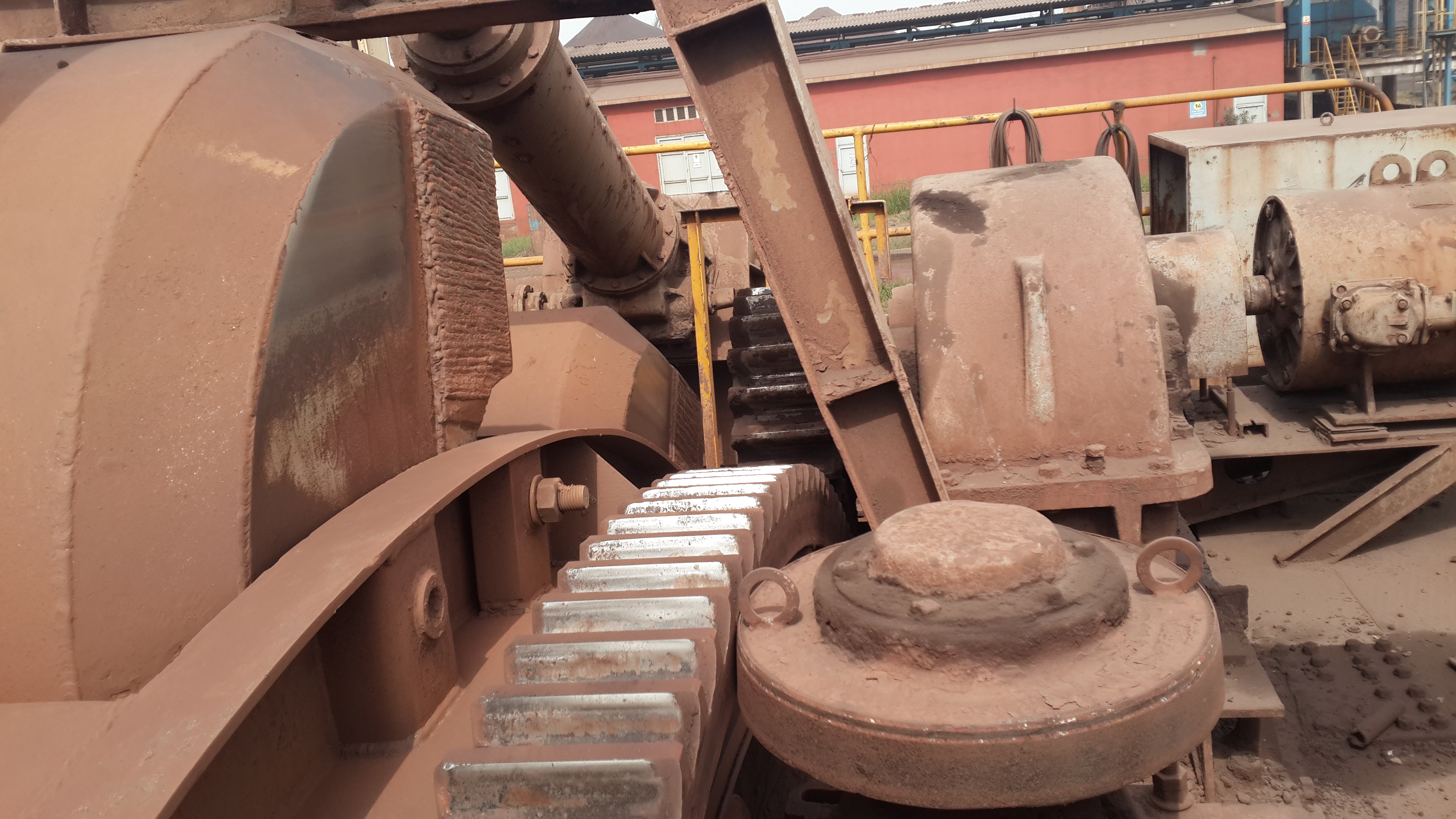
If There Is A Hard Way ...
... to do a job somebody is certain to find or design it. Within this bucket wheel action there is severe and continuous compression of a hollow ring(s) coupled with planar deflections as the ring travels across the pile face.However adequate the restraint, extreme forces are always there. You know this of course. The machines work in hostile conditions and exposure to wear should be minimised. Chain drives, for whatever purpose, do not fit the bill in this instance. Duplicate drives double the exposure to misalignment problems although presumably it was meant to counterbalance. The single gear drive acknowledges the inevitability of float and since it develops a single line of contact it is better able to accommodate that misalignment. Using 2 chains suggest that probably they were optimised to operate near their limit. Have you checked the sprocket wear or damage situation? If the gearbox has a misalignment compensation it can accommodate some measure of the misalignment whereas a chain drive does not have that luxury.
As often in these threads a picture or drawing would be most helpful.
You might need to examine the life expectancy of the reclaimer against the cost comparison of new chains and a new gearbox installation together with the downtime and engineering risk. Your calculations would probably suggest that if there is vacant time to undertake the modification then you probably didn't need such a machine in the first place. Sorry boys: it might be the British weather. ■
John Gateley johngateley@hotmail.com www.the-credible-bulk.com
Re: Bridge Type Bucket Wheel Drive System


Thank you for your kind response and valuable explanations.
Please find the fotos of both reclaimers at the attachment.
Your further comments after reviewing these fotos we will highly appreciated.
Best regards, ■
The Value Of Pictures.
Thanks for the photos.
The chain drive blows me out of the water. It seems that only the left hand drive does any real work and the right hand unit just takes up the slack chain because there is no take up provided for what is a really heavy chain. Large chains are found as rim drives on kilns and because of the larger wrap angle the motor can be 'stretched' into a tensile action. If, or when, your right hand drive is adjusted it can only reduce the wrap angle. This will mean that less teeth are taking more individual load. Whether you can adjust the right hand wrap is immaterial because the drive is doing nothing: except slackening the chain approaching the ring gear. So when you stop the buckets they are more likely to overrun and impart severe loading on the chain pins. I would shift the right hand drive sprocket nearer to the machine centre to increase the wrap. There should also be some scope for tightening on this sprocket mounting. Take it downwards with a big screw.
then your only problem will be finding a buyer for the redundant right hand drive.
Misalignment is doubled by your 2 drives. Tucking the right hand sprocket like I suggest will reduce the misalignment and that will help even more. There is far too much chain, slack chain, and this machinery does not tolerate unnecessary rubbing between the links are they negotiate too muck catenary sag. Another cause of wear failure there.
Yours is a classic case of faulty drawing review bearing fruit. I would have spotted the fault before I'd finished opening the drawing. ■
John Gateley johngateley@hotmail.com www.the-credible-bulk.com
Further..
I just noticed the fluid couplings. These might have been well intentioned but they are counter-productive when there are 2. During stopping the wheel can overrun and the chain approaching the LH drive unit becomes slackened. This is not good for restart purposes. Start up relies on the LH drive and the entire RH drive can be replaced by a brake and of course the sprocket.
Harrows, AKA rakes, mean trouble. I was presented with a claim that harrows tried to make the material stand at an angle beyond it's natural repose. Somebody was trying intellectual arrogance. The tines scrape the product away. End of story. The claim was intended to mask the fact that the particular harrow had fallen down and nearly killed some quarrymen. Please, please check that your harrow ropes are in good condition and well dressed (lubricated).
I hope I have given you food for thought and wish you well in your struggle with the Flintstones. ■
John Gateley johngateley@hotmail.com www.the-credible-bulk.com
Thanks
So many valuable information. Will try to find out the best way to solve the problem. Thank you so much for your kind support and professional review of the matter in detail.
I would definetely share the results of our study. Hope it helps people to learn from this experience. ■
Chain Vs. Spur Gear
fully supporting Johns views on the faulty drive design, I'd like to chip in the following
- chain drives of BWheels are common in the industry & run to the satisfaction of many
- one centered drive with 2 holddown sprockets and a chain take-up functionality are a solution seen in the industry with VFD as a drive option.
- if correctly designed, the toothed rim is segmented and bolted to the substructure --> changeout is possible. There the spur gear cannot easily compete.
- to refurbish the chain type design to a spur gear design shall be difficult, the bearing structure of the BW is very compressed, densely filled and specifically shaped to support the respective power transmission element
- I perceive the twin drive solution to provide for a leading and a trailing drive respective to the changing working directions of the reclaimer. Intent of the designer was surely to impart driving power at both instances and the flc to enable load sharing at unsynchronized local rpm. So before cutting off one unit you need to check whether one drive will make the wheel move under all circumstances and in both working directions of the reclaimer.
- smooth and aligned running of the BW, stringent limitation of axial float as well as correct alignment of the sprockets are THE task for the chain drive system --> what does the supplier say on this (Jap.?)?
- spur gear designs require proper alignment as well, if I read the pic. correctly it is only one drive to the BW --> so this might really be the deciding difference between your two different applications
Regards
R. ■
Still Talking.
An overhead central drive with sufficient control would provide a better remedy if there is available space upstairs. Two tensioners could keep the chain really tight and the overhead drive could be made sympathetic to the wheel distortions. This would be more expensive than leaving the drive lower down.
It might be worth while to examine gear sectors which are readily available for mills and kilns. These could replace the chain drive and standardise future spares across the stockyard. One of the existing drives could be converted, in situ, to a variable speed unit with a spur gear fitted. This was, in essence, the starter's original proposal.
Chain drives, as shown, can be improved at minimum cost. Gearing will perhaps cost more and might not be as reliable as the other spur gear drive in the long run. It seems to be a case of the devil you know is better than the devil you don't know. ■
John Gateley johngateley@hotmail.com www.the-credible-bulk.com




Bridge Type Bucket Wheel Drive System
We have two bridge type reclaimers. The first one is driven by a motor and spur wheel gear. The second is driven by two electrical motor and chain wheel gear.
Actually, we have some problems with the chain drive. If there is a misalignment between chain gear and wheel gear which is caused by guide rollers, the chain is broken in a short while. But, generally the second reclaimer, with spur gear drive, is more stronger in the same misalignment conditions. Because of this reason, our intend is revamp the second bridge type reclaimer by spur gear system.
So, could you please share your opinions and experience about the advantages and disadvantages of using chain gear or spur gear drive system for the bucket whell drive?
Could you also please give any information if you have knowledge or experience for the alternative drive technologies for bucket wheel?
Thanks in advance for your sharings. ■